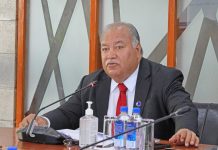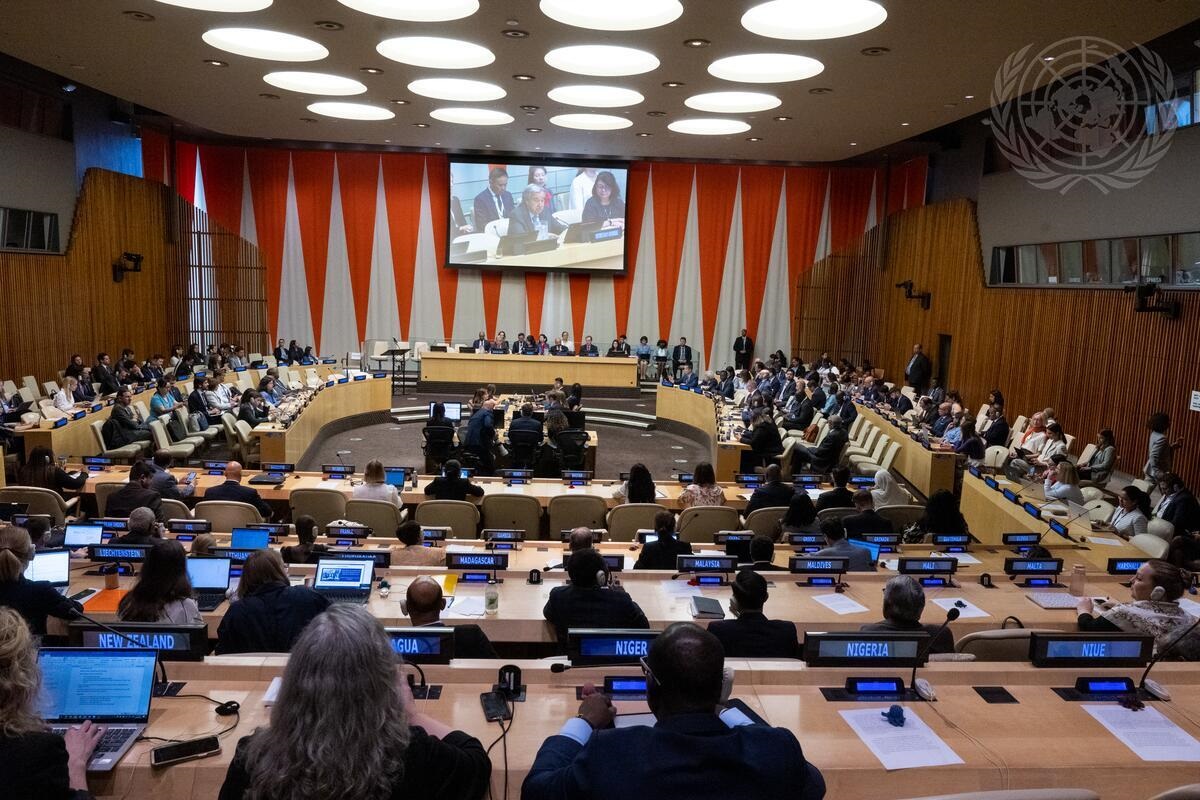The world’s first international treaty to protect the high seas was adopted Monday at the United Nations, creating a landmark environmental accord designed to protect remote ecosystems vital to humanity.
Secretary-General Antonio Guterres hailed as a “historic achievement” the treaty that will establish a legal framework to extend swathes of environmental protections to international waters, which make up more than 60 percent of the world’s oceans.
“The ocean is the lifeblood of our planet and today you have pumped new life and hope to give the ocean a fighting chance,” he told delegates.
He commended the adoption of the agreement as a demonstration of the strength of multilateralism.
“By acting to counter threats to our planet that go beyond national boundaries, you are demonstrating that global threats deserve global action”, he said, “and that countries can come together, in unity, for the common good”.
Following more than 15 years of discussions, including four years of formal negotiations, UN member states finally agreed on the text for the treaty in March after a flurry of final, marathon talks.
The text, since frozen, has been pored over by the UN’s lawyers and translators to make sure it matches in the body’s six official languages.
“Countries must now ratify it as quickly as possible to bring it into force so that we can protect our ocean, build our resilience to climate change and safeguard the lives and livelihoods of billions of people,” said Rebecca Hubbard of the High Seas Alliance.
The @UN has officially adopted the #BBNJ treaty text to protect the #HighSeas. A win for conservation, a win for multilateralism. https://t.co/YHpRzSrr2j pic.twitter.com/mS2EUXfyL5
— Nichola Clark (@HighSeasPolicy) June 19, 2023
Scientists have increasingly come to realise the importance of oceans, which produce most of the oxygen we breathe, limit climate change by absorbing CO2, and host rich areas of biodiversity, often at the microscopic level.
But with so much of the world’s oceans lying outside of individual countries’ exclusive economic zones, and thus the jurisdiction of any single state, providing protection for the so-called “high seas” requires international cooperation.
The result is that they’ve been long ignored in many environmental fights, as the spotlight has been on coastal areas and a few emblematic species.
A key tool in the treaty will be the ability to create protected marine areas in international waters.
Currently, only about one percent of the high seas are protected by any sort of conservation measures.
The treaty is seen as crucial to countries protecting 30 percent of the world’s oceans and lands by 2030, as agreed by world governments in a separate historic accord reached in Montreal in December.
With it, “We are giving ourselves the means to achieve” the 30-percent target, said the French Secretary of State for the Sea, Herve Berville.
He called for a “sprint” towards ratification so that the accord enters into force by the next UN Ocean Conference in Nice, France in June 2025.
Chris Thorne of Greenpeace’s Protect the Oceans campaign said: “This Treaty is a win for all life on this planet. Now those same governments which agreed it must urgently ratify and begin delivering vast ocean sanctuaries on the high seas. The science is clear, we must protect at least 30 percent of the oceans by 2030 to give the oceans a chance to recover and thrive.
“2030 looms large on the horizon, and the scale of our task is vast. Less than one percent of the high seas is protected. Millions of people from all over the world have demanded change and together we have achieved this historic agreement, but we still have a long way to go.
“We are committed to achieving 30×30. We will work day and night to ensure this Treaty is ratified in 2025, and ocean sanctuaries free from destructive human activities covering 30 percent of the oceans become a reality by the end of this decade,” he said
The treaty, officially known as the treaty on “Biodiversity Beyond National Jurisdiction” or BBNJ, also introduces requirements to carry out environmental impact studies for proposed activities to be carried out in international waters.
Such activities, while not listed in the text, would include anything from fishing and maritime transport to more controversial pursuits, like deep-sea mining or even geo-engineering programs aimed at fighting global warming.
The treaty also establishes principles for sharing the benefits of “marine genetic resources” (MGR) collected by scientific research in international waters—a sticking point that almost derailed last-minute negotiations in March.
Developing countries, which often don’t have the money to finance such expeditions, fought for benefit-sharing rights, hoping to not get left behind by what many see as a huge future market in the commercialisation of MGR, especially by pharmaceutical and cosmetic companies searching for “miracle molecules.”
The treaty will open for signatures on 20 September, when dozens of heads of state will be in New York for the UN General Assembly.
It remains to be seen how many countries will decide to come on board.
Russia itself from the treaty as soon as it was adopted, declaring some elements of the text “categorically unacceptable”.
NGOs believe that the threshold of 60 ratifications required for it to enter into force should be reachable since the High Ambition Coalition for the BBNJ— which pushed for the treaty—counts some 50 or so countries as members, including those of the European Union, as well as Chile, Mexico, India and Japan.
But 60 is far from the universal adoption—the UN has 193 member states—that defenders of the ocean are pushing for.
“Let’s carry this momentum forward. Let’s continue working to protect our oceans, our planet, and all the people on it,” said UN General Assembly President Csaba Korosi.
The effective and timely implementation of this Agreement will make crucial contributions to achieving the ocean-related goals and targets of the 2030 Agenda for Sustainable Development and the Kunming-Montreal Global Biodiversity Framework.
The Agreement addresses four key issues.
“It sets up a framework for the fair and equitable sharing of benefits arising from activities with respect to marine genetic resources and digital sequence information on marine genetic resources of areas beyond national jurisdiction, ensuring that such activities benefit all of humanity.
“It will enable the establishment of area-based management tools, including marine protected areas, to conserve and sustainably manage vital habitats and species in the high seas and the international seabed area. Such measures are critical for archiving the “30 by 30” global target to effectively conserve and manage at least 30 percent of the world’s terrestrial and inland water areas, and of marine and coastal areas by 2030, as agreed in the Kunming-Montreal Global Biodiversity Framework.
“It will ensure that environmental impacts of activities in areas beyond national jurisdiction are assessed and considered in decision-making. It also provides, for the first time, an international legal framework for the assessment of the cumulative impacts of activities and the consequences of climate change, ocean acidification and related impacts, in areas beyond national jurisdiction
“And it will facilitate cooperation in capacity-building and the transfer of marine technology to assist Parties, in particular developing States Parties, in achieving the objectives of the Agreement, so as to level the playing field for all States to responsibly utilise and benefit from marine biodiversity of areas beyond national jurisdiction,” a UN statement said.
The Agreement addresses several cross-cutting issues, such as its relationship with the United Nations Convention on the Law of the Sea and relevant legal instruments and frameworks and relevant global, regional, subregional and sectoral bodies, as well as funding and dispute settlement. It also sets up institutional arrangements, including a Conference of the Parties, a Scientific and Technical Body and other subsidiary bodies of the Conference of the Parties, a Clearing-House Mechanism and a secretariat.
The Agreement will be open for signature at United Nations Headquarters in New York for two years from 20 September 2023, the day after the 2023 SDG Summit. It will enter into force after ratification by sixty States.
The Secretary-General is required to convene the first meeting of the Conference of the Parties to the Agreement no later than one year after its entry into force.
The Secretary-General urged all States to spare no effort to ensure that the Agreement enters into force, and called on them to act without delay to sign and ratify it as soon as possible.
“This is critical to addressing the threats facing the ocean, and to the success of ocean-related goals and targets — including the 2030 Agenda and the Kunming-Montreal Global Biodiversity Framework”, he said.
He also expressed readiness to help States make this happen.
“The path towards ratification and early implementation will require concerted efforts by States, stakeholders and the UN system. Coordination of these efforts and cooperation will be of utmost importance,” the UN statement said.
SOURCE: AFP/UN NEWS/PACNEWS














